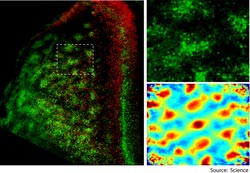A Grid in the Brain

A grid-like network of nerve cells in the brain (left, and top right) shows a similar hexagonal organization (right, bottom) to the mental map formed by the nerve cells in the brain. Science<br>
Animals and humans find their way through the world using an internally generated navigation system. In mammals, components of this navigational system are the hippocampus and the entorhinal cortex.
These structures memorize and represent our environment in form of a cognitive map, which is a mental representation of space. The representation of space in the entorhinal cortex is particularly fascinating—here, nerve cells discharge in a grid like pattern across space when the animal is moving.
It is thought that this so-called grid cell activity works much like the grid lines on a map providing mammals with a metric for space. So far, it has been unclear how such grid patterns of activated nerve cells are anatomically formed in the brain.
Now, a research team headed by Leibniz prize winner Professor Michael Brecht from the Humboldt-Universität in Berlin, the Cluster of Excellence Neurocure, and the Bernstein Center Berlin has discovered a grid-like network of nerve cells in the entorhinal cortex. By using a protein that binds to calcium in selected nerve cells, the scientists visualized a small circuit of nerve cells. The dendrites of these neurons formed a hexagonal pattern in space that had a striking resemblance to the known grid patterns. Moreover, the neurons in this network showed the same characteristic activity rhythm as the grid cells, when the researchers measured the nerve cell activity in moving animals.
“People have known that the brain divides places into grids, much like we draw lines on a map. However, what was not known is what causes the brain to do it. What we have shown here is the existence of a circuit in the brain, which physically looks like the spatial activity pattern of the so-called grid cells. This makes us think that this circuit structure might be the underlying cause of this representation”, Brecht comments on the study that has been published in the renowned scientific journal Science this Thursday.
Hence, the discovery of the neural network might help us to understand how the brain generates grid lines on our mental maps and how we mentally measure distances. The scientists also hope to gain insight into how the brain forms spatial memories—a brain function which is disturbed or lost in many neurodegenerative diseases such as dementia. On a more fundamental level, how the brain forms spatial memories may be related to how we form memories in general: as in the memory palaces of the ancient Greeks, objects could be linked with places to serve as a mnemonic device.
The Bernstein Center Berlin is part of the National Bernstein Network Computational Neuroscience in Germany. With this funding initiative, the German Federal Ministry of Education and Research (BMBF) has supported the new discipline of Computational Neuroscience since 2004 with over 170 million Euros. The network is named after the German physiologist Julius Bernstein (1835-1917).
Contact:
Prof. Dr. Michael Brecht
Bernstein Center Berlin
Humboldt-Universität zu Berlin
Philippstr. 13, House 6
10115 Berlin
Tel: +49 (0)30 2093 6718
Email: michael.brecht@bccn-berlin.de
Original publication:
S. Ray, R. Naumann, A. Burgalossi, Q. Tang, H. Schmidt & M. Brecht (2014): Grid-layout and Theta-modulation of Layer 2 Pyramidal Neurons in Medial Entorhinal Cortex. Science, Advanced Online Publication.
Weitere Informationen:
http://www.activetouch.de Lab of Michael Brecht
http://www.bccn-berlin.de Bernstein Center Berlin
http://www.hu-berlin.de Humboldt-Universität Berlin
http://wwww.nncn.de National Bernstein Network Computational Neuroscience
Media Contact
More Information:
http://wwww.nncn.deAll latest news from the category: Life Sciences and Chemistry
Articles and reports from the Life Sciences and chemistry area deal with applied and basic research into modern biology, chemistry and human medicine.
Valuable information can be found on a range of life sciences fields including bacteriology, biochemistry, bionics, bioinformatics, biophysics, biotechnology, genetics, geobotany, human biology, marine biology, microbiology, molecular biology, cellular biology, zoology, bioinorganic chemistry, microchemistry and environmental chemistry.
Newest articles

High-energy-density aqueous battery based on halogen multi-electron transfer
Traditional non-aqueous lithium-ion batteries have a high energy density, but their safety is compromised due to the flammable organic electrolytes they utilize. Aqueous batteries use water as the solvent for…

First-ever combined heart pump and pig kidney transplant
…gives new hope to patient with terminal illness. Surgeons at NYU Langone Health performed the first-ever combined mechanical heart pump and gene-edited pig kidney transplant surgery in a 54-year-old woman…

Biophysics: Testing how well biomarkers work
LMU researchers have developed a method to determine how reliably target proteins can be labeled using super-resolution fluorescence microscopy. Modern microscopy techniques make it possible to examine the inner workings…





















